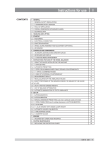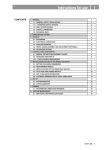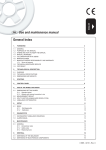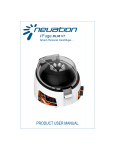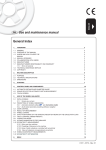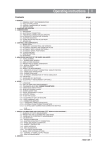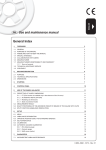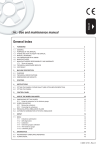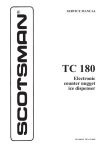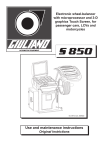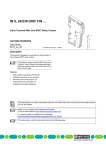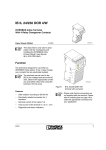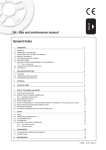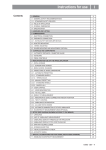Download MegaSpin 250 Lv (Eng)
Transcript
I INSTRUCTIONS FOR USE CONTENTS 1 - GENERAL 3 1.1 - GENERAL SAFETY REGULATIONS 3 1.1.1 - STANDARD SAFETY DEVICES 3 1.2 - FIELD OF APPLICATION 3 1.3 - MAIN PARTS 3 1.4 - OVERALL DIMENSIONS 3 1.5 - TECHNICAL DATA 4 2 - HANDLING, LIFTING 4 2.1 - ANCHORING 4 3 - START- UP 5 3.1 - ELECTRICAL CONNECTION 5 3.2 - ADAPTER MOUNTING 5 3.3 - WHEEL MOUNTING 5 4 - CONTROLS AND COMPONENTS 6 4.1 - CONTROL PANEL AND DISPLAY 6 4.2 - AUTOMATIC DISTANCE AND DIAMETER GAUGE 6 4.3 - WHEEL LIFTING DEVICE 6 4.4 - MANUAL SPINNING DEVICE 6 5 - INDICATIONS AND USE OF THE WHEEL BALANCER 7 5.1 - DATA SETTING 7 5.2 - RESULT OF MEASUREMENT 8 5.2.1 - BATTERY CHARGE INDICATION (OPTION) 8 5.2.2 - MODIFYING SET DIMENSIONS 9 5.2.3 - EXACT POSITIONING OF THE ADHESIVE WEIGHT BY MEANS OF THE GAUGE WITH CLIPS 9 5.2.4 - SPLIT FUNCTION (HIDDEN ADHESIVE WEIGHTS) 10 5.2.5 - UNBALANCE OPTIMIZATION 11 5.2.6 - ALU AND STATIC MODES 11 5.2.7 - AUTOMATIC MINIMIZATION OF STATIC UNBALANCE 11 6 - SET UP 12 6.1 - MENU 12 6.2 - AUTOMATIC GAUGES CALIBRATION 13 6.2.1 - RIM DISTANCE GAUGE 13 6.2.2 - DIAMETER GAUGEE40 M 13 6.3 - BALANCING MACHINE CALIBRATION 14 7 - ERRORS 15 7.1 - INCONSISTENT UNBALANCE READINGS 16 8 - ROUTINE MAINTENANCE (SEE EXPLODED DRAWINGS) 16 8.1 - TO REPLACE THE FUSES 16 8.2 - PRECAUTIONS FOR BATTERY USE 16 I 0677 GB - 1 I 0677 GB - 2 1 - GENERAL ► 1.1 - GENERAL SAFETY REGULATIONS ■ The machine should only be used by authorized and suitably trained personnel. ■ Do not use the machine for purposes other than those specified in this manual. ■ The machine should not be modified in any way except for those modifications explicitly carried out by the firm. ■ Never remove the safety devices. Any work on the machine should only be carried out by specialist per sonnel. ■ Carefully clean the coupling surfaces before performing any operation. ■ Avoid using strong jets of compressed air for cleaning. ■ Use alcohol to clean the plastic panel or shelves (AVOID LIQUIDS CONTAINING SOLVENTS). ■ Before starting the wheel balancing cycle, make sure that the wheel is securely locked on the adapter. ■ The machine operator should avoid wearing clothes with flapping edges. Make sure that unauthorized personnel do not approach the machine during the work cycle. ■ Avoid placing objects inside the base as they could impair the correct operation of the machine. ► 1.1.1 - STANDARD SAFETY DEVICES ■ The wheel guard is not compulsory since the balancing speed is less than 100 min-1. ► 1.2 - FIELD OF APPLICATION The machine is designed for balancing wheels of cars and motor vehicles weighing up to 250 kg. It can be operated in the temperature range of 0°C to + 45°C. The following functions are provided: ALUM, SPLIT; Unbalance optimization; Self diagnostics; Self calibration. ► 1.3 - MAIN PARTS LEVA SOLLEVAMENTO LIFTING LEVER CALIBRO AUTOMATIC AUTOMATICO GAUGE TASTIERA E CONTROL PANEL DISPLAY AND DISPLAY MANDRINO SHAFT ASSEMBLY LEVA DI LANCIO SPINNING LEVER RUOTE PER MOVIMENTAZIONE WHEELS TO MOVE THE WHEEL BALANCER ► 1.4 - OVERALL DIMENSIONS I 0677 GB - 3 ► 1.5 - TECHNICAL DATA Single-phase power supply 12 - 24 V DC 0,15 A Protection class IP 54 Balancing speed 70 min-1 TRUCK Balancing speed 100 min-1 CAR Cycle time 8-20 seconds Balancing accuracy 1 gram (car) - 10 grams (truck) Position resolution ± 0.7° Average noise < 70dB (A) Rim-machine distance 0 - 300 mm Rim width setting range 1.5” ÷ 20” or 40 ÷ 510 mm Diameter setting range 10” ÷ 30” or 265 ÷ 765 mm Max. wheel diameter 1300 mm 2 - HANDLING, LIFTING THE WHEEL BALANCER MUST BE MOVED USING THE HANDLE AND THE WHEELS AND RAISED BY PRISING ON THE BASE ONLY AT THE THREE POINTS INDICATED. NEVER, UNDER ANY CIRCUSTANCE, APPLY FORCE TO OTHER POINTS SUCH AS THE SPINDLE, HEAD, OR ACCESSORY SHELF. ► 2.1 - ANCHORING The machine can operate on any flat non resilient floor without having to be anchored to the floor. Make sure that the machine rests on the 3 mounting points provided. I 0677 GB - 4 3 - START- UP ► 3.1 - ELECTRICAL CONNECTION The machine is supplied with an AC power supply and power cable with 12-24 VDC battery. The supply voltage is given on the machine nameplate. It cannot be changed. Connection to mains should always be made by expert personnel. ► 3.2 - ADAPTER MOUNTING 3 ► The wheel balancer is supplied complete with cone type adapter for fastening wheels with central bore. The threaded terminal is fitted according to the drawing; it can be removed to fit optional adapters. ► 3.3 - WHEEL MOUNTING The wheels should be fastened with one of the numerous adapters available. Incorrect centering inevitably causes unbalance. I 0677 GB - 5 4 - CONTROLS AND COMPONENTS ► 4.1 - CONTROL PANEL AND DISPLAY 2 1 5 13 6 3 15 3-4 5 6 7 8 6 8 9 12 1-2 10 4 6 16 6 11 14 Digital readouts, AMOUNT OF UNBALANCE, inside/outside Digital readouts, POSITION OF UNBALANCE, inside/outside Indicators, correction mode selected Indicators, selection made Push button, unbalance reading < 5 g (25 oz) Push button, ounces/grams selection 9 10 11 12 13 14 15 16 7 Push button, selection of mode of correction SPLIT push button (unbalance resolution) Push button, FUNCTIONS MENU Push button, menu selection confirmation Push button, car/truck selection HOME Push button Push buttons, manual dimensions setting Position repeat ONLY USE THE FINGERS TO PRESS THE PUSH BUTTONS. NEVER USE THE COUNTERWEIGHT PINCERS OR OTHER POINTED OBJECTS. ► 4.2 - AUTOMATIC DISTANCE AND DIAMETER GAUGE This gauge allows measurement of the distance of the wheel from the machine and the wheel diameter at the point of application of the counterweight. It also allows correct positioning of the counterweights on the inside by using the specific function (see INDICATION OF EXACT CORRECTION WEIGHT POSITION ) which allows reading the position used for the measurement within the rim. ► 4.3 - WHEEL LIFTING DEVICE Allows lifting the wheel from the ground without using a lift in order to spin it. It also allows lowering the wheel until it touches the ground in order to stop rotation ► 4.4 - MANUAL SPINNING DEVICE Allows spinning the tyre until when the machine display turns off; this means that the minimum spindle rotation speed has been reached to perform correct balancing (72’/min. for trucks and 100’/min. for cars). At this point, release the handle and wait until the unbalance measured appears on the display. If the beep function is enabled (see MENU), a beep will sound when the correct balancing speed is reached. I 0677 GB - 6 5 - USE OF THE WHEEL BALANCER ► 5.1 - DATA SETTING Press the button → balancing machine set in car mode ; LED on The balancing data is set by means of an "intelligent" automatic gauge; confirmation of the measurement and the position appear on the display. The round part of the gauge must rest on the rim where the weight will be positioned. a b While the gauge is moving the following appears when the measurement has been stored ; . a) standard weights: When only one measurement is made, the machine interprets the presence of a rim with clipon weight correction The width value (b) must be set with the buttons measured with the compass gauge provided. . The correct measurement is that which can be b b) adhesive weights: Make two successive measurements on two correction planes inside the rim. The balancing machine automatically interprets that the correction will be made with adhesive weights and the following appears: For a different combination of the type or position of the weights on the rim, use the button . I 0677 GB - 7 ► 5.2 - RESULT OF MEASUREMENT ► Unbalance display pitch: Car = 1/5 g (.1/0.25 Oz) is pressed, the unbalance is displayed with pitch: When Car = Truck = 10/50 g (.25/1 Oz) 1g .1 Oz Truck = 10 g .25 Oz ► Unbalance display threshold Car = 5 g (.4 Oz) Truck = 50 g (2 Oz) Inside correction Outside correction After performing a balancing spin, the amounts of unbalance are shown on the digital readouts. Digital readouts with LED’s 3- 4 lit up indicate the correct angular wheel position to mount the counterweights (12 o’clock position). 0 If the unbalance is less than the threshold selected is displayed instead of the unbalance. With possible to read the values below the threshold chosen. NB: it is For wheel diameters less than or equal to 13” and at temperatures around 0° C, the wheel balancer automatically initiates a special measurement cycle involving two consutive measurements. The precision of unbalace values and the reliability of the wheel balancer are unaffected. If the mobile symbol should apper at the end of any balancing start operation, turn the wheel by hand until the unbalance values are displayed. If the battery is low, the symbol will appear on the screen. ► 5.2.1 - BATTERY CHARGE INDICATION (OPTION) Displays the battery charge. To access the function, see MENU MANAGEMENT Battery low Battery 50% charged Battery fully charged or with 12V power supply I 0677 GB - 8 ► 5.2.2 - MODIFYING SET DIMENSIONS If the wheel dimensions have been entered incorrectly, the parameters can be modified without repeating the balancing spin by pressing : access parameter modification → (select to modify: (a) distance, (b) width, (d) diameter → to obtain the new measurement or: pull out the gauge to repeat the measurement → to obtain the new measurement. ► 5.2.3 - EXACT POSITIONING OF THE ADHESIVE WEIGHT BY MEANS OF THE GAUGE WITH CLIPS Press the button if using the correction method with weights on the inside of the rim. ■ ■ Fit the correction weight in the specific gauge seat with the adhesive part facing upwards Bring the wheel into correct angular position for the plane to be corrected. ■ Pull the gauge further outwards. ■ Return the gauge to the rest position. ■ INSIDE CORRECTION POSITION ■ OUTSIDE CORRECTION POSITION ■ When the weight application distance has been reached a beep is sounded (can be deactivated). ■ rotate the gauge until the correction weight adheres to the rim ■ the fact that the weight application position is no longer vertical is automatically compensated ■ to cancel this function, press button again. I 0677 GB - 9 ► 5.2.4 - SPLIT FUNCTION (HIDDEN ADHESIVE WEIGHTS) The SPLIT function is used to position the adhesive weights behind the wheel spokes so that they are not visible. This function should be used in ALU mode where the adhesive weight is applied on the outside. Input the wheel dimensions and do a spin. 2 1 ■ Turn the wheel to the outside unbalance correction position as indicated by the machine 1 2 ■ Position one spoke at 12 o'clock (e.g. 1) and press 2 1 ■ Following the rotation direction indicated on the display, position spoke 2 at 12 o'clock and press 1 2 ■ Position the wheel as indicated by the LEDs. The unbalance is indicated on the right-hand display 2 1 ■ Repeat the operation for the other spoke To return to normal unbalance display, press any button. NOTE: The distance between the spokes must be at least 18° and at most 120° (if not, the errors 24,25 or 26 appear). Spokes with irregular or inconstant angles can be compensated. I 0677 GB - 10 ► 5.2.5 - UNBALANCE OPTIMIZATION ■ This function serves to reduce the amount of weight to be added in order to balance the wheel. ■ It is suitable for static unbalance exceeding 30 g. ■ It improves the residual eccentricity of the tyre. ■ This operation is required if no unbalance has been measured previously; otherwise go to the next step ■ Mark with chalk a reference point on the adapter and rim. ■ With the aid of a tyre remover, turn the tyre on the rim by 180°. ■ Refit the wheel with the reference mark coinciding between rim and adapter. ■ Perform a manual spin under normal conditions ■ RH display: percentage reduction ■ LH display: actual static unbalance which can be reduced by rotation. ■ Mark the two positions of the rim and tyre, and turn the tyre on the rim until the positions correspond in order to obtain the optimization on the display. ■ RETURN TO MEASUREMENT SCREEN. ► 5.2.6 - ALU AND STATIC MODES From the measurement screen, press the button to select all the possible types of corrections. The (5)-LED displays show the position where to apply the weights. If a spin has already been performed, the processor automatically recalculates, for each change of mode, the amounts of unbalance according to the new calculation. ► 5.2.7 - AUTOMATIC MINIMIZATION OF STATIC UNBALANCE Initial unbalance sx dx g phase shift g 50° Possible approximations sx sx dx g residual static 4 g g sx dx g residual static g 3g sx dx g residual static g 1g With conventional Choice with minimum wheel balancer static residual dx g residual static g 6g This program is designed to improve the quality of balancing without any mental effort or loss of time by the operator. In fact by using the normal commercially available weights, with pitch of 5 in every 5 g, and by applying the two counterweights which a conventional wheel balancer rounds to the nearest value, there could be a residual static unbalance of up to 4 g. The damage of such approximation is emphasized by the fact that static unbalance is cause of most of disturbances on the vehicle. This new function automatically indicates the optimum entity of the weights to be applied by approximating them in an “intelligent” way according to their position in order to minimize residual static unbalance. I 0677 GB - 11 6 - SET UP ► 6.1 - MENU See chapter on UNBALANCE OPTIMIZATION diameter unit of measure mm/inch width unit of measure mm/inch approximates 1-5g or 0.1-.25 oz approximates 10-50g or .25/1oz Displays the battery charge values on/off beep signal Calibration of automatic RIM DISTANCE gauge Calibration of automatic DIAMETER gauge RETURNS TO MEASUREMENT SCREEN I 0677 GB - 12 ► 6.2 - AUTOMATIC GAUGES CALIBRATION ► 6.2.1 - RIM DISTANCE GAUGE ■ Leave the distance gauge in rest position and press ■ Pull out the gauge up to the adapter flange and press ■ CORRECT CALIBRATION Return the gauge to rest position. The wheel balancer is ready for operation. N.B.: In the event of errors or faulty operation, the writing “r.P.”: appears on the display : shift the gauge to the rest position and repeat the calibration operation exactly as described above. If the error persists, contact the Technical Service Department. In the event of incorrect input in the rim distance gauge calibration function, press to cancel it. E40 m ► 6.2.2 - DIAMETER GAUGE ► ► ► m ■ Place the round part of the gauge terminal on the flange as shown in the figure and press ■ The number 8 ± 3° appears on the left display . ■ Turn the gauge downward position the round part of the gauge terminal at 40 mm (radial distance) from the flange as indicated in the figure; alternatively use one of the cones provided as shown in the images 40 mm ■ The number 289 ± 3° should appear on the left display. The calibration is already correct. ■ If not, press the button holding the gauge still at 40 mm: the number 289 appears on the left display. ■ Return the gauge to rest position. I 0677 GB - 13 ► 6.3 - BALANCING MACHINE CALIBRATION To calibrate the machine, operate as follows: ■ Fit a medium-sized wheel with steel rim on the shaft. Example: 6” x 15” (± 1”) best with less then 20 g unbalance ■ Take the exact measurements of the wheel mounted as described in DATA SETTING. PRESETTING OF INCORRECT DIMENSIONS WOULD MEAN THAT THE MACHINE IS NOT CORRECTLY CALIBRATED, THEREFORE ALL SUBSEQUENT MEASUREMENTS WILL BE INCORRECT UNTIL A NEW SELF-CALIBRATION IS PERFORMED WITH THE CORRECT DIMENSIONS! ■ Perform a manual spin under normal conditions ■ Add a sample weight on the outside in any angular position. Sample weight: 60 g. (2.00 .oz) for car 300 g. (10.0 .oz) for truck Perform a manual spin ■ I 0677 GB - 14 ■ Shift the sample weight from the outside to the inside keeping the same angu lar position. ■ Perform a manual spin ■ Turn the wheel until the sample weight is in the 12 o’clock position ■ END OF CALIBRATION ■ CANCELS CALIBRATION IN ANY PHASE. 7 - ERRORS During machine operation, various causes of faulty operation could occur. If detected by the microprocessor, they appear on the display as follows: ERRORS CAUSES CONTROLS Black The wheel balancer does not come on. 1. 2. 3. Check proper connection to the mains. Check and if necessary replace the fuses on the power board. Replace the computer board. Err. 1 No rotation signal. 1. 2. 3. 4. Check belt tautness. Check in self-diagnostics that the encoder functions properly. Replace the phase generator. Replace the computer board. Err. 2 Too low speed during measurement. During the unbalance measurement revolutions, the wheel speed has fallen to below 42 rpm. 1. Check that a vehicle wheel has been mounted on the wheel balancer. Check belt tautness. Check in self-diagnostics that the encoder functions properly. Replace the computer board. Too high unbalance. 1. 2. 3. 4. Err. 3 2. 3. 4. 5. Err. 4 Check the wheel dimension setting. Check the sensor connections. Run the machine calibration function. Mount a wheel with a more or less known unbalance (less than 100 grams) and check the machine response. Replace the computer board. Rotation in opposite direction. After pressing [START], the wheel starts turning in the opposite direction (anticlockwise). 1. 2. Verify the connection of the UP/DOWN - RESET signals on the phase encoder. Check the bearing/spring of the phase generator Err. 5 Guard open The [START] pushbutton was pressed without first closing the guard. 1. 2. 3. 4. Reset the error. Close the guard. Verify the function of the protection uSwitch. Press the [START] button. Err. 7 / Err. 8 / Err. 9 NOVRAM parameter read error 1. 2. 3. 4. 5. Repeat machine calibration Shut down the machine. Wait for at least ~ 1 min. Restart the machine and check proper functioning. Replace the computer board. Err. 11 Too high speed error. The average spinning speed is greater than 240 rpm. 1. 2. 3. Check if there is any damage or dirt on the timing disc. Check in self-diagnostics that the encoder functions properly Replace the computer board. Err.14/ Err.15/ Err.16/ Err.17/ Err. 18/ Err. 19 Unbalance measurement error. 1. 2. 3. 4. 5. Check functioning of the phase generator. Check the sensor connections. Check the machine earthing connection. Mount a wheel with a more or less known unbalance (less than 100 grams) and check the machine response. Replace the computer board. Err.21 Motor on for more than 15 seconds. 1. 2. 3. Check functioning of the phase generator. Check the connections on the power board. Replace the computer board. Err.22 Maximum number of spins possible for the unbalance measurement has been exceeded. 1. 2. 3. 4. Check that a vehicle wheel has been mounted on the wheel balancer. Check belt tautness. Check in self-diagnostics that the encoder functions properly Replace the computer board. Err. 23 The wheel does not slow down 1. 2. 3. Remember to release the spinning device when the displays go off Check functioning of the phase generator. Replace the computer board. Err. 24 Distance between the spokes smaller than 18 degrees. 1. The minimum distance between the spokes where to split the unbalance must be greater than 18 degrees Repeat the SPLIT function increasing the distance between the spokes. 2. Err. 25 Distance between the spokes greater than 120 degree 1. 2. The minimum distance between the spokes where to split the unbalance must be smaller than 120 degrees Repeat the SPLIT function increasing the distance between the spokes. I 0677 GB - 15 Err. 26 First spoke too far from unbalance position 1. 2. Battery low 1. The minimum distance between the unbalance position and the spoke must be less than 120 degrees. Repeat the split function reducing the distance between the spokes. Recharge the battery ► 7.1 - INCONSISTENT UNBALANCE READINGS Sometimes after balancing a wheel and removing it from the balancing machine, it is found that, upon mounting it on the machine again, the wheel is not balanced. This does not depend on incorrect indication of the machine, but only on faulty mounting of the wheel on the adapter; i.e. in the two mountings, the wheel has assumed a different position with respect to the balancing machine shaft centre line. If the wheel has been mounted on the adapter with screws, it could be possible that the screws have not been correctly tightened, i.e. crosswise one by one, or else (as often occurs) holes have been drilled on the wheel with too wide tolerances. Small errors, up to 10 grams (0.4 oz) are to be considered normal in wheels locked by a cone; the error is normally greater for wheels fastened with screws or studs. If, after balancing, the wheel is found to be still out-of-balance when refitted on the vehicle, this could be due to the unbalance of the car brake drum or very often due to the holes for the screws on the rim and drum sometimes drilled with too wide tolerances. In such case a readjustment could be advisable using the balancing machine with the wheel mounted. 8 - ROUTINE MAINTENANCE (see exploded drawings) (for non specialized personnel only Switch off the machine from the mains before carrying out any operation. ► 8.1 - TO REPLACE THE FUSES Remove the weight holder shelf to gain access to the power supply board where the fuses are located (see Exploded Drawings). If fuses require replacement, use ones of the same current rating. If the fault persists, contact the Technical Service Department. ► 8.2 - PRECAUTIONS FOR BATTERY USE To keep the battery efficient over time, do not expose it to direct sunlight, avoid contact with liquids and do not connect the output in short-circuit. NONE OF THE OTHER MACHINE PARTS REQUIRE MAINTENANCE. I 0677 GB - 16

















